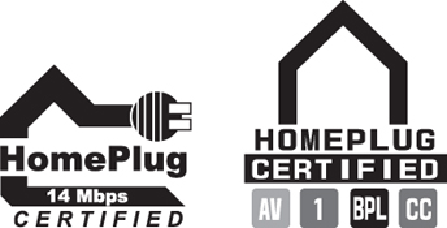Hardware Reference
In-Depth Information
The HomePlug Powerline Alliance uses certification marks to indicate which HomePlug
certifications are supported by a particular device.
Figure 17.22
shows the original and
new HomePlug certification marks.
Figure 17.22
The HomePlug Powerline Alliance certification marks. The original mark (left) for
HomePlug 14Mbps network devices only is being replaced by the new multipurpose mark (right).
Putting Your Network Together
In this section is a detailed checklist of the hardware and software you need to build your
network.
First, start with the number of computers you plan to network. You need the items dis-
cussed in this section to set up your network.
Network Adapters
Every system needs a network adapter or interface card. These are normally built in but
can also be added in the form of a card or external USB device.
Traditionally,networkadaptersarealsocalled
network interface cards (NICs)
.Tosimplify
technical support and minimize the number of drivers you have to deal with, where pos-
sible I recommend you use the same make and model of NIC for each computer in your
network.
For the best performance in a wired network, I recommend using only Gigabit Ethernet
components, especially with regards to NICs and switches. If your system has a built-in
Fast Ethernet (100Mbps) NIC, you might consider replacing it with a Gigabit Ethernet
card. I recommend PCI-Express-based Gigabit NICs for desktop computers and Ex-
pressCard Gigabit NICs for laptop computers with ExpressCard slots. (ExpressCard in-
cludes the PCI-Express bus.) If these slots are not available, use PCI or CardBus cards
instead.

